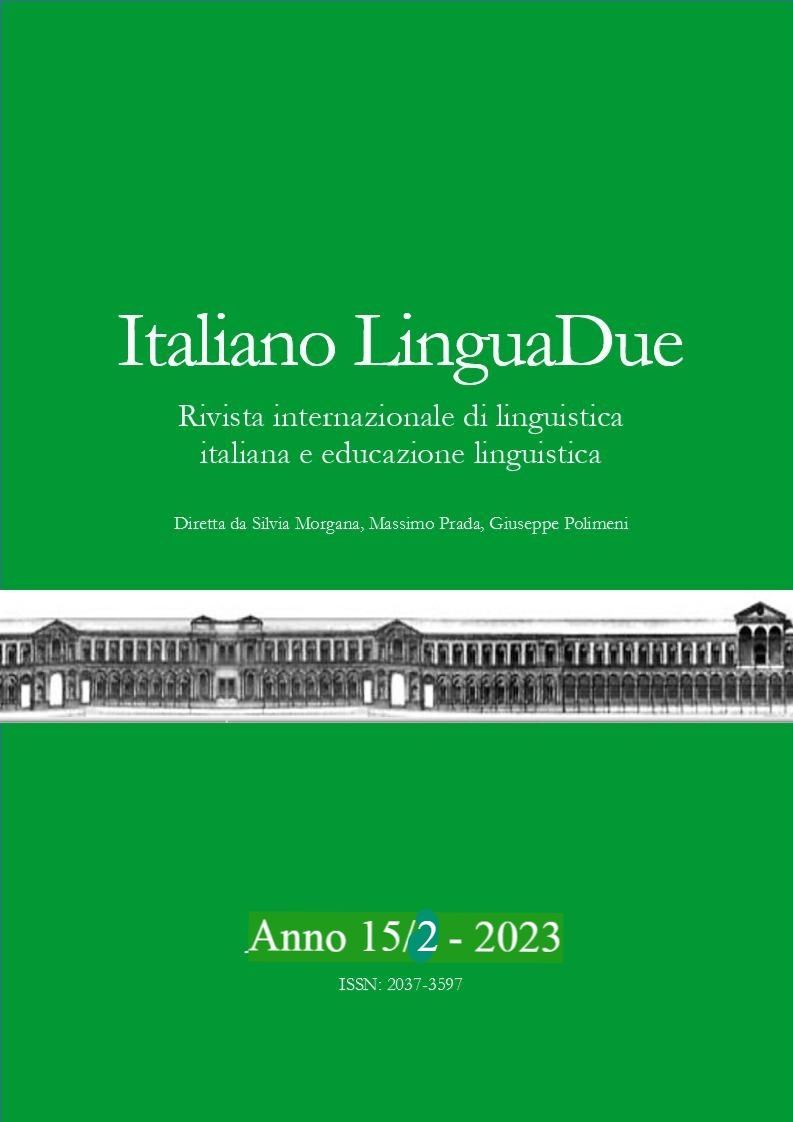PRAGMATIC MARKERS AS CONTEXT BOUNDARIES IN INDONESIAN HUMOROUS TALK SHOWS DISCOURSE
DOI:
https://doi.org/10.54103/2037-3597/22026Abstract
In building a successful conversation, speakers are bound to bring proper linguistic devices to keep the hearer’s understanding in processing the appropriate inferences beyond the utterances. This study aims to investigate the function of pragmatic markers in creating context boundaries in the cognitive process (Kecskes & Zang, 2014). Pragmatic markers are believed not only to serve the coherence of the discourse but also to signal the speaker’s cognitive process (Blakemore, 1987:144). In this case, pragmatic markers function to guide the hearers in picking up the interlocutor’s knowledge (Nordenstam, 1992) in creating humor. The corpus data used in this study is collected from manual transcription (with annotation) of 10 chosen humorous talk show videos in Indonesian. The investigation focuses on pragmatic marker lho used in Indonesian humorous discourse which suggests that the conversational humor is creatively created with the high frequency of the communicating speaker’s knowledge to create incongruity to fill the conversation with unexpected or even unrealistic ideas that people never imagine. As a result, pragmatic markers lho play essential roles in guiding the hearer to the intended context so that they can choose the appropriate inferences based on the shared knowledge that leads them to grab the humorous sense of the utterances.
Marcatori pragmatici come confini del contesto nel discorso dei talk show umoristici indonesiani
Nella costruzione di una conversazione di successo, i parlanti sono tenuti a mettere in atto dispositivi linguistici adeguati per mantenere la comprensione dell’uditore nell’elaborazione delle inferenze appropriate al di là degli enunciati. Questo studio si propone di indagare la funzione dei marcatori pragmatici nel creare confini contestuali nel processo cognitivo (Kecskes, Zang, 2014). Si ritiene che i marcatori pragmatici non servano solo alla coerenza del discorso, ma anche a segnalare il processo cognitivo del parlante (Blakemore, 1987). In questo caso, i marcatori pragmatici hanno la funzione di guidare gli uditori a cogliere le conoscenze dell’interlocutore (Nordenstam, 1992) nel creare umorismo. I dati del corpus utilizzati in questo studio sono tratti dalla trascrizione manuale (con annotazione) di 10 video di talk show umoristici in indonesiano. L’indagine si concentra sul marcatore pragmatico lho utilizzato nel discorso umoristico indonesiano, che suggerisce che l’umorismo conversazionale è creato in modo creativo con l’alta frequenza delle conoscenze del parlante per creare incongruenza e riempire la conversazione con idee inaspettate o addirittura irrealistiche che le persone non avrebbero mai immaginato. Di conseguenza, i marcatori pragmatici lho svolgono un ruolo essenziale nel guidare l’uditore verso il contesto previsto, in modo che possa scegliere le inferenze appropriate in base alla conoscenza condivisa che lo porta a cogliere il senso umoristico degli enunciati.
Riferimenti bibliografici
Blakemore D. (1987), Semantic Constraints on Relevance, Blackwell, Oxford.
Carrel A. (1997), “Joke competence and humor competence”, in Humor, 10, 2, pp. 173-185.
Flamson T. J., Bryant G. A. (2013), “Signals of humor: encryption and laughter in social interaction”, in Dynel M. (ed.), Development in linguistic humor theory, John Benjamins Publishing Company, Amsterdam, pp. 49-73.
Glenn P. (2003), Laughter in interaction, Cambridge University Press, Cambridge.
Goldstein J., McGhee P. (eds.) (1972), The psychology of humor: Theoretical perspectives and empirical issues, Academic Press, New York.
Ikranagara K. (1974), Lexical particle in Betawi. Ph.D. Dissertation, University of Hawaii.
Karaj D. M. (2021), “Indonesian discourse particles”, in Wacana, 22, 2, pp. 319-337.
Kecskes I., Zhang F. (2009), “Activating, seeking, and creating common ground A socio-cognitive approach”, in Pragmatics & Cognition, 17, 2, pp. 331-355.
Keith-Spiegel P. (1972), “Early conceptions of humour: Varieties and issues”, in Goldstein J., McGhee P. (eds.), The psychology of humour: Theoretical perspectives and empirical issues, Academic Press, New York, pp. 3-39.
Mutiara R. (2017), “Particle kok in child language: Stance and positions”, in Yanti (ed.), Celebrating corpus tools. Proceedings of the the 4th Atma Jaya Conference on Corpus Studies, Jakarta, pp. 11-15
Mutiara R. (2019), “Co-occurences of kok and other markers in colloquial Jakartan Indonesian”, in Journal of Pragmatics Research, 1, 1, pp. 43-61.
Nordenstam K. (1992), “Tag questions and gender in Swedish conversations”, in Working papers on language, gender and sexism, 2, 1, pp. 75-86.
Norrick Neal R. (2003), “Issues in conversational joking”, in Journal of Pragmatics, 35, 9, pp. 1333-1359: https://doi.org/10.1016/S0378-2166(02)00180-7.
Poedjosoedarmo S. (1987), Javanese influence on Indonesian, Pacific Linguistics, Department of Linguistics Research School of Pacific Studies, The Australian National University, Canberra.
Raskin V. (1985), Semantic mechanisms of humor, D. Reidel Publishing Company, Dordrech.
Roberts A. (2019), A philosophy of humor, Palgrave Macmillan, London.
Sari F. (2009), “A prosodic aspect of the Indonesian pragmatic particle sih”, Paper presented at International Symposium on Malay/Indonesian Linguistics, Sengiggi, Lombok, Indonesia, 6-7 June: https://doi.org/10.1017/CBO9781107415324.004.
Sneddon J. (2003), The Indonesian language: its history and role in modern society, University of New South Wales Press Ltd, Randwick (Sydney).
Sneddon J. N. (2006), Colloquial Jakartan Indonesian., The Australian National University, Canberra:
https://openresearch-repository.anu.edu.au/bitstream/1885/146284/1/581_Sneddon.pdf.
Sneddon J. N., Adelaar K. A., Djenar D. N., Ewing M. C. (2010), Indonesian Reference Grammar, Allen & Unwin, Sidney.
Wouk F. (1998), “Solidarity in Indonesian conversation: The discourse marker kan”, in Multilingua, 17, pp. 379-406.
Wouk F. (1999), “Gender and the use of pragmatic particles in Indonesian, in Journal of Sociolinguistics, 3/2, pp. 194-219.
Wouk F. (2001), “Solidarity in Indonesian conversation: The discourse marker ya”, in Journal of Pragmatics, 33, pp. 171-191.
Dowloads
Pubblicato
Fascicolo
Sezione
Licenza

Questo lavoro è fornito con la licenza Creative Commons Attribuzione - Condividi allo stesso modo 4.0.




